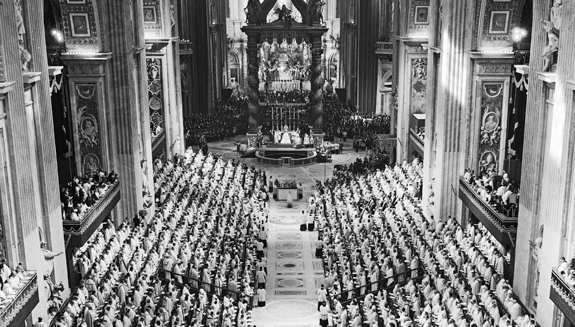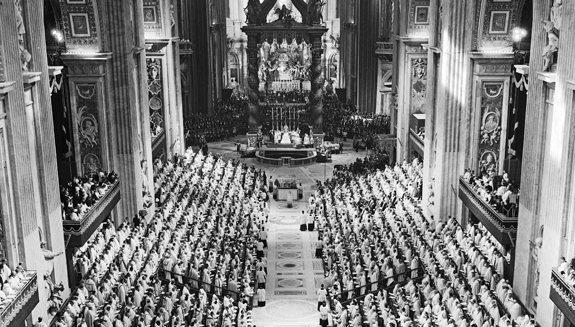
In a June post at the website Where Peter Is, author Steven Millies, having ritually denounced the “senseless [Catholic] culture war quarrel” and taken another tiresome sideswipe at Bishop Robert Barron’s criticism of “beige Catholicism,” informed us that we must recover Vatican II vision of “a Church determined to meet the modern world.”
Yet as I thought I had demonstrated in two books (The Irony of Modern Catholic History and To Sanctify The World), Vatican II did not call the Church to just “meet the modern world.” The Council called the Church to convert the modern world. How? By offering Jesus Christ as the icon of a genuine humanism and the sacramental Church as the icon of authentic human community.
That this was Pope John XXIII’s intention in summoning Vatican II is quite clear from the radio address he delivered on September 11, 1962, a month before the Council opened.
Preparatory work for Vatican II had been underway for years. The bishops had submitted agenda items for conciliar discussion. Draft documents for the council fathers to consider had been prepared. St. Peter’s had been transformed into a giant conference hall, with fifteen rows of upholstered bleachers occupying the basilica’s vast nave, from the red porphyry disk on which Pope Leo III had crowned Charlemagne “Holy Roman Emperor” in 800 to Bernini’s massive bronze baldacchino over the papal high altar. (There were even coffee bars built so that the successors of the apostles could refresh themselves; they were quickly dubbed “Bar-Jonah” and “Bar-Abbas.”)
John XXIII had read the draft conciliar documents that would be debated and saw that they were largely written in an abstract vocabulary, devoid of much grounding in Scripture or the Fathers of the Church. A patient man, he was content to let the Council find its own “voice.” But as the Council found that voice, he wanted to lay down a marker: Vatican II would not repeat settled Catholic truths for the sake of repeating them; the Council would link settled truths to evangelical mission.
To drive that point home, the elderly pope, who knew that he had terminal cancer, spent considerable time crafting an address in which he would underscore just why 2,500 bishops were coming to Rome — and he may well have hoped to offer a critical interpretive lens through which to read those pre-prepared documents the bishops would consider.
John XXIII’s September 1962 radio address was the most explicitly evangelical and Christocentric pre-conciliar statement of his intentions for Vatican II, laying down themes he would develop in his epic opening address to the Council. Yes, the Church must “meet” the “modern world,” as it had once “met” the medieval world and the classical world. But with what would the Church “meet” modernity?
The Church would meet the modern world with the proclamation made by Christ himself: “The Kingdom of God is in the midst of you” (Luke 17:21). And that, John XXIII said in his radio address, must be the message of the Council: “This phrase, ‘Kingdom of God,’ expresses fully and precisely the work of the Council. ‘Kingdom of God’ means and is in reality the Church of Christ, one, holy, catholic, and apostolic, the one which Jesus, the Word of God made man, founded and which for twenty centuries he has preserved, just as still today he gives her life by his presence and grace.”
To foster that encounter with the incarnate Word of God had been the purpose of every previous ecumenical council: “What in fact has an ecumenical council ever been but the renewing of this encounter with the face of the risen Jesus, glorious and immortal king, shining upon the whole Church for the salvation, joy, and splendor of the human race?”
Then John XXIII defined with precision the reason for Vatican II: “Of fundamental importance is what is said about the very reason for the Council’s being held: at issue is the response of the whole world to the testament of the Lord which he left us when he said, ‘Go, teach all nations…’ The purpose of the Council is, therefore, evangelization” [emphasis added].
In proclaiming Jesus Christ as the answer to the question that is every human life, and in witnessing through the sacraments and the works of charity that the Kingdom of God is among us, Catholicism is, was, and always will be a culture-reforming counterculture, challenging every culture in which it finds itself to realize its noblest aspirations through friendship with the incarnate Son of God.
That inevitably causes friction, which is sometimes severe. To live in that friction is not, pace Dr. Millies, “senseless.” It’s inevitable. Recognizing that is what Lutheran pastor and martyr Dietrich Bonhoeffer called the “cost of discipleship.”
(George Weigel’s column ‘The Catholic Difference’ is syndicated by the Denver Catholic, the official publication of the Archdiocese of Denver.)
If you value the news and views Catholic World Report provides, please consider donating to support our efforts. Your contribution will help us continue to make CWR available to all readers worldwide for free, without a subscription. Thank you for your generosity!
Click here for more information on donating to CWR. Click here to sign up for our newsletter.












